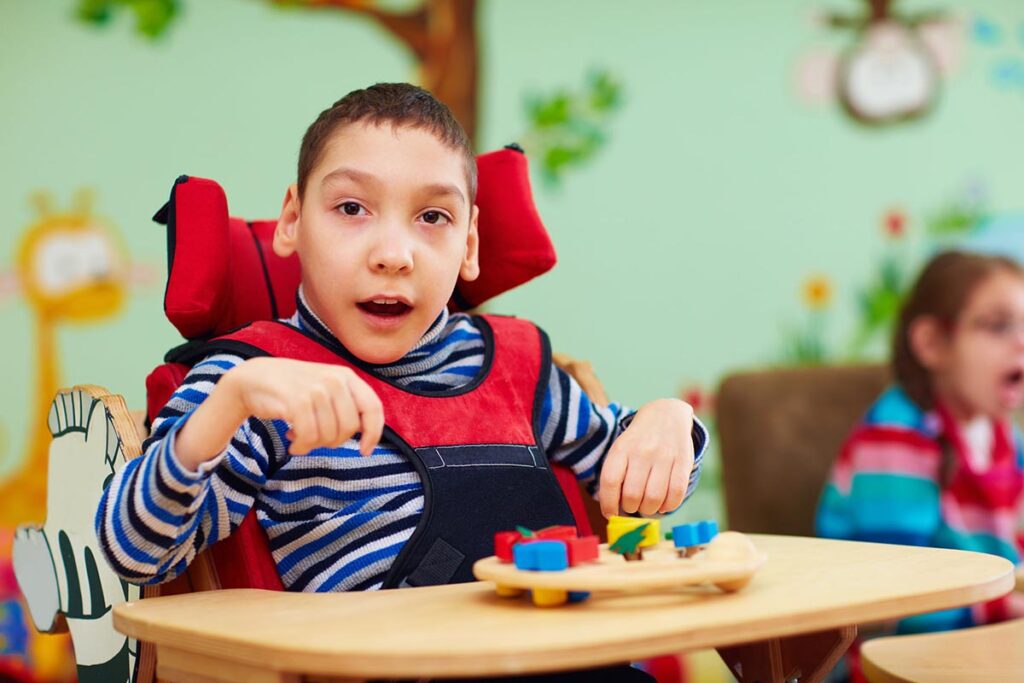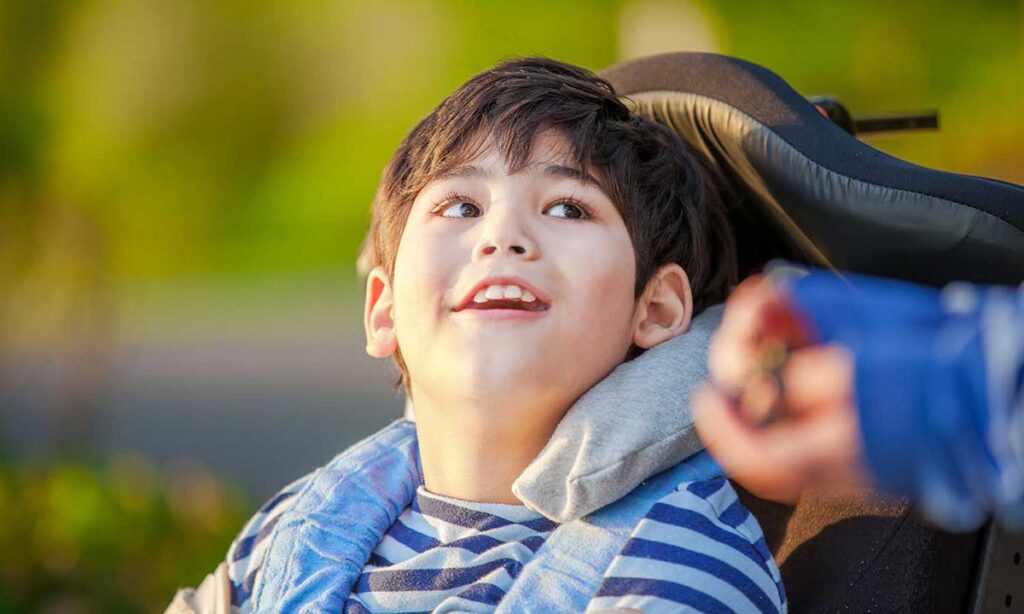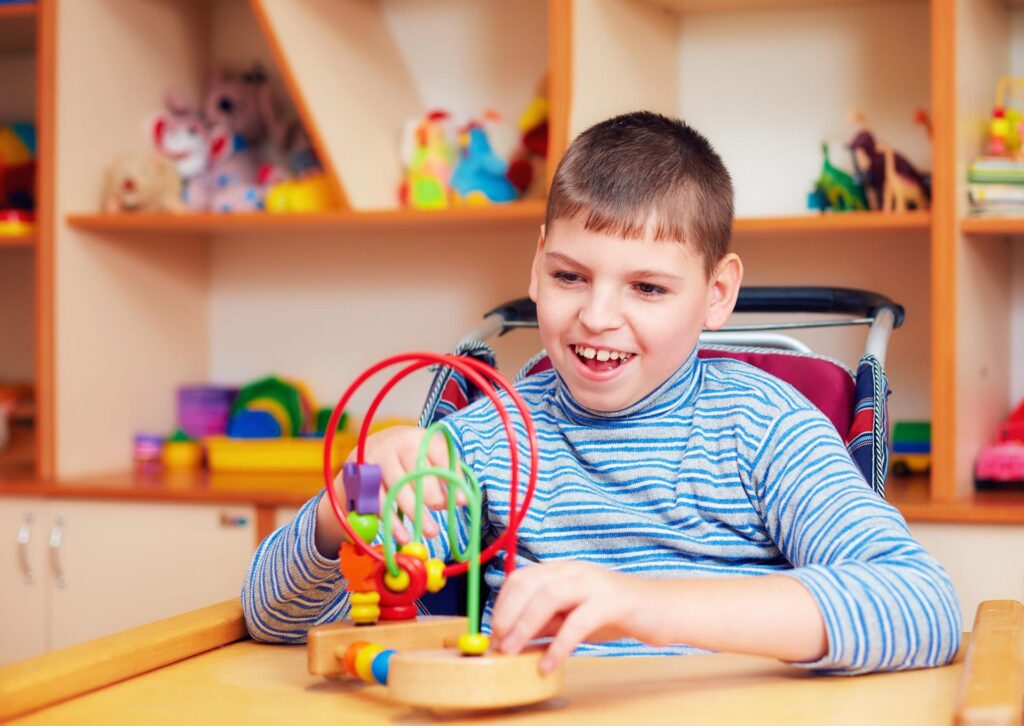Cerebral palsy (CP) is a lifelong neurological condition that profoundly impacts movement, muscle tone, and coordination. It arises from changes in the brain occurring before, during, or after birth. However, with personalised and compassionate support, individuals with cerebral palsy can lead fulfilling and independent lives. In this blog, we address the diverse types of cerebral palsy and innovative treatment strategies and explore associated challenges that can coexist with cerebral palsy.
What Is Cerebral Palsy?
Cerebral palsy (CP) is a neurological condition that affects muscle tone, movement, and coordination. It can also affect vision, hearing, and sensation.
The word ‘cerebral’ refers to the areas of the brain that regulate motor function, and the word ‘palsy’ means challenges with the muscles. Combined, it is a change in the brain during development that causes difficulties with a person’s ability to move and control muscles.
Cerebral palsy is one of the most common causes of motor disabilities in childhood, and 1 in 100 children has cerebral palsy in the UK. Most people are born with cerebral palsy, which is called “congenital cerebral palsy”. However, some people acquire cerebral palsy after birth, known as “acquired cerebral palsy”.
Types of Cerebral Palsy
Depending on which areas of the brain are affected, there are several different types of CP:
- Spastic cerebral palsy
- Dyskinetic cerebral palsy
- Ataxic cerebral palsy
- Hypotonic cerebral palsy
- Mixed cerebral palsy
It’s important to note that the symptoms of cerebral palsy can change over a person’s lifetime. Knowing the effects and noticing symptoms earlier can help identify the right tailored care and support.

Spastic Cerebral Palsy
Spastic cerebral palsy is the most common type of cerebral palsy, and it affects about 80% of people.
The characteristics of spastic cerebral palsy are stiffness and firm muscles, and challenges in making movements. Spastic cerebral palsy is considered an umbrella term for these three different types:
- Spastic hemiplegia – impacts one side of the body (usually the arm more than the leg), and a person with this type of CP can still walk. Challenges with speech are typical for spastic hemiplegia.
- Spastic diplegia – muscle stiffness impacts the lower half of the body, so a person can still walk but with assistive devices. Arms are less affected.
- Spastic quadriplegia – impacts the upper and lower limbs, body, torso, and face. It makes mobility difficult, and often people are unable to walk.
Dyskinetic Cerebral Palsy
Dyskinetic cerebral palsy is characterised by fluctuating muscle tone and involuntary movements. People with this type of CP face difficulty controlling the movement of hands, arms, feet, and legs. They have a challenge with sitting and walking. In some cases, it affects the face and tongue, and it can be difficult for a person to swallow or talk.
The clinical diagnosis of dyskinetic cerebral palsy typically occurs within 18 months of birth. This type of cerebral palsy is further divided into two different types:
- Athetoid cerebral palsy – movements are slow, affecting the face and fingers
- Choreoathetoid cerebral palsy – involuntary movements, affecting toes and fingers
Ataxic Cerebral Palsy
Ataxic cerebral palsy causes challenges with balance and coordination. Movements such as writing and walking can be difficult. People with this type of cerebral palsy also have difficulty controlling their hands or arms, especially in situations when they reach for something or make quick movements.
Hypotonic Cerebral Palsy
Hypotonic cerebral palsy reduces muscle tone and causes overly relaxed muscles. It can lead to weak muscles, poor mobility and excessive flexibility. Children with hypotonic cerebral palsy have difficulty speaking, challenges with reflexes, and difficulty with walking or sitting.
Mixed Cerebral Palsy
Individuals with mixed cerebral palsy have diverse symptoms of different types of cerebral palsy. Among the most common combinations is spastic and dyskinetic cerebral palsy. Mixed CP is the most difficult to treat because it is heterogeneous and unpredictable in its development over a lifetime. However, individuals still benefit from proactive treatment to reduce challenges and improve their quality of life.
Cerebral Palsy Symptoms
The symptoms of cerebral palsy affect people differently. Some people with CP may have more emphasised symptoms and need support and complex care, while others may have fewer challenges and less need for assistance and lifelong care.
However, symptoms of cerebral palsy can change. Common symptoms include challenges with movement, coordination, speech, eating, and development.
Now, let’s take a closer at the signs and symptoms of cerebral palsy.

Movement and Coordination
Challenges with movement and coordination are common symptoms of cerebral palsy, including
- Stiff muscles and strong reflexes
- Variations in muscle tone, for example, increased muscle tone
- Slow movements
- Frequently using one side of the body, for example, reaching only with one hand
- Difficulties with fine motor skills
- Difficulty walking and tiptoeing
Speech
Speech and language difficulties are common in people with cerebral palsy. Some of the symptoms involve:
- Delays in speech development
- Difficulty speaking
- Difficulties with fluency
- Challenges with facial expressions
Eating
Cerebral palsy can cause difficulty with preparing and consuming food. The symptoms include the following:
- Difficulty with chewing
- Difficulty with swallowing
- Excessive saliva
- Challenge holding utensils
Motor Development
Difficulties with motor development are common symptoms of cerebral palsy, including:
- Delays with reaching the motor skills milestones, such as crawling
- Learning difficulties
- Intellectual difficulties
- Delayed growth
Other Challenges
The changes in the brain that cause cerebral palsy can also lead to other neurological challenges and conditions. Among them are the following:
- Seizures
- Difficulty hearing
- Challenges with vision
- Challenges with pain sensations
- Mental health
- Emotional and behavioural challenges
Cerebral Palsy Diagnosis
Early diagnosis of cerebral palsy plays a crucial role in improving the overall life quality of individuals. By promptly identifying it and implementing a personalised treatment plan, individuals with CP can experience significant improvements in their daily lives.
The diagnostic process involves a series of comprehensive tests and evaluations, which may include:
- Blood tests
- Computed tomography (CT)
- Magnetic resonance imaging (MRI)
- Ultrasounds (for assessing neurological health in infants)
- Electroencephalogram (EEG) to eliminate the possibility of coexisting conditions like epilepsy
As childhood progresses, additional factors such as health history, physical observations, and developmental milestones are considered in the diagnosis process, primarily focusing on identifying motor or movement delays.
In most cases, children with cerebral palsy receive a confirmed diagnosis by age two, enabling timely intervention and support. When doctors suspect CP, they often recommend consulting a specialist, such as a neurologist, to ensure accurate assessment and appropriate management.
Once a child is diagnosed, a tailored treatment plan comes into action, encompassing physical and speech therapy and targeted muscle training. These individualised plans are essential, as they address each child’s specific needs and challenges, empowering them to reach their full potential and enhance their overall well-being.
Causes of Cerebral Palsy
Cerebral palsy is a neurological condition characterised by changes within the brain, which can occur before, during, or after birth. The causes of cerebral palsy can vary, and several factors may lead to its development. Some of the potential causes include:
- Bleeding in the baby’s brain (haemorrhaging)
- Reduced blood supply and oxygen deprivation (asphyxia) in the baby’s brain
- Infections in the mother during pregnancy (e.g., Rubella)
- Injuries to the baby’s brain either before or after birth
Certain risk factors have been associated with an increased likelihood of cerebral palsy. Among these risk factors are toxic exposures during pregnancy, such as exposure to drugs or alcohol, low birth weight, premature birth, and being part of multiple births. Understanding these risk factors can help identify high-risk pregnancies and guide efforts to mitigate potential causes or complications that may lead to cerebral palsy.
Cerebral Palsy Caused by Medical Negligence
Unfortunately, there are cases when a child can develop cerebral palsy during birth due to medical negligence from medical professionals.
Examples of medical negligence include:
- Ineffectiveness to detect or adequately treat infections
- Ineffectiveness in detecting changes in the heart rate of the foetus
- Ineffectiveness to schedule or perform C-section
- Improper use of delivery tools, such as vacuum extractors and forceps
Even though medical professionals are trained to provide high-quality care during birth, negligence can happen. In cases of medical negligence, families can take legal action.

Associated Conditions with Cerebral Palsy
People can experience additional health challenges and difficulties alongside cerebral palsy. Some of the associated challenges with cerebral palsy include:
- Attention deficit hyperactivity disorder (ADHD)
- Autism Spectrum Disorder (ASD)
- Chronic pain
- Epilepsy
- Mental health challenges
- Speech disorders
- Sleep challenges
- Hearing challenges
- Vision challenges
- Behavioural and emotional difficulties
Cerebral Palsy Treatment
Early intervention with appropriate therapies and treatments can play a crucial role in mitigating symptoms, enhancing mobility, and preventing potential complications of cerebral palsy.
Treatment options for this lifelong condition are diverse and tailored to meet the specific needs of each individual. Assistive aids such as glasses, hearing aids, and typing aids, along with mobility aids like walkers and wheelchairs, offer invaluable support to improve daily functioning. Healthcare professionals may also prescribe medications to address specific symptoms and challenges associated with cerebral palsy. In certain cases, surgical interventions targeting muscles, ligaments, or nerves can help alleviate pain and improve mobility, contributing to a higher quality of life.
For individuals with cerebral palsy, comprehensive treatment plans may encompass various therapies to address specific aspects of their condition. Speech and language therapy can be instrumental in improving speech articulation and language skills, while occupational therapy equips children to manage daily activities with greater independence. Physical therapy enhances balance and mobility, helping individuals with cerebral palsy achieve their maximum physical potential. Additionally, recreational therapy, psychotherapy, and social services consultations provide further support, fostering emotional well-being.
By combining these treatment approaches, individuals with cerebral palsy can lead fulfilling lives and embrace their unique abilities with confidence and empowerment.
Cerebral Palsy Life Expectancy
A person with cerebral palsy typically has an average lifespan.
Early diagnosis and proper therapy improve the quality of life for people with cerebral palsy. Without early intervention, there is a risk of complications with some symptoms associated with cerebral palsy.
However, most people diagnosed with cerebral palsy receive adjustments during the education process and in the work environment, leading independent life as adults.
Ongoing research and advancements in treatment approaches offer hope for improved outcomes and better quality of life for individuals with cerebral palsy.
Cerebral Palsy Care with LD Network
LD Network provides person-centred support for people with complex care needs and transforms care for the better. We believe everyone deserves to have a fulfilling and meaningful life, and we make it our mission to improve the well-being of every person we serve.
With our tailored treatment plans, we help people with cerebral palsy achieve positive outcomes. Our committed and dedicated teams provide constant support, assisting people to live as independently as possible.
Contact us for more information and a personalised treatment plan, or visit our Exeter office.












